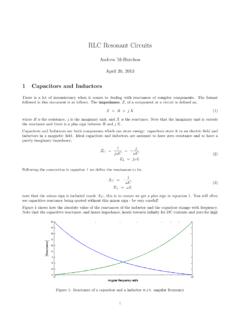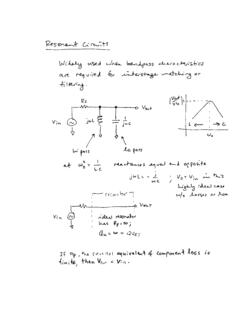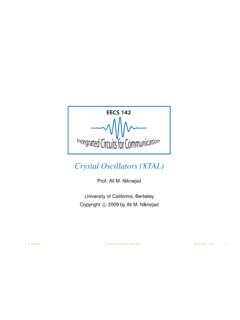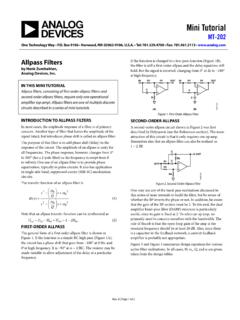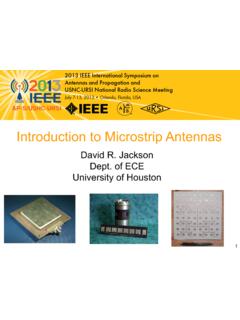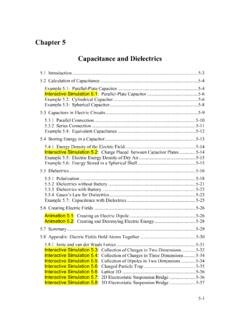Transcription of Oscillator Circuits
1 1 Oscillator Circuits2II. Oscillator OperationFor self-sustaining oscillations: the feedback signal must positive the overall gain must be equal to one (unity gain)3If the feedback signal is not positive or the gain is less than one, then the oscillations will dampen the overall gain is greater than one, then the Oscillator will eventually of Oscillator Bridge Oscillator Oscillator5A. Phase-Shift OscillatorFrequency of the Oscillator : (the frequency where the phase shift is 180 )Feedback gain = 1/[1 5 2 j (6 3) ]where = 1/(2 fRC)Feedback gain at the frequency of the Oscillator = 1 / 29 The amplifier must supply enough gain to compensate for losses.
2 The overall gain must be unity. Thus the gain of the amplifier stage must be greater than 1/ , A > 29 The RC networks provide the necessary phase shift for a positive feedback. They also determine the frequency of RCf=6 Example of a Phase-Shift OscillatorFET Phase-Shift Oscillator7 Example 18 BJT Phase-Shift OscillatorCCfeRRRRh42923++>iehRR = 9 Phase-shift Oscillator using op-amp10B. Wien Bridge OscillatorSo frequency of oscillation is()2211021 CRCR f=11114321434212+ +=+ += ==RRZZRRRZZZVVVVV abdoi2 and ,21 then and When4302121 =====RR RC fCCCRRR frequency noscillatio theat phase zero have should , ,21212 ZZZZZ+122143 0 CCRRRR+= = 11 Calculate the resonant frequency of the Wien bridge Oscillator shown )101)(1051 (2121930= == RCfExample 212C.
3 Tuned Oscillator CircuitsTuned Oscillators use a parallel LC resonant circuit (LC tank) to provide the are two common types: Colpitts The resonant circuit is an inductor and two capacitors. Hartley The resonant circuit is a tapped inductor or two inductors and one Tuned Oscillator CircuitFET based Colpitts Oscillator2121 where ,210 CCCCCLC feqeq+==Frequency of oscillations:14 Transistor Colpitts Colpitts Tuned Oscillator CircuitFET Hartley Oscillator12212 where ,210 LLLLCL feqeq++==Frequency of oscillations:17 BJT based Hartley Oscillator18D.
4 Crystal OscillatorsThe crystal appears to the rest of the circuit as a resonant resonant FrequenciesThe crystal has two resonant frequencies: series resonant :RLC determine the resonant frequency. The crystal has a low resonant :RL and CMdetermine the resonant frequency. The crystal has a high series and parallel resonant frequencies are very close, within 1% of each resonant Crystal OscillatorFET Crystal Oscillator21 Parallel resonant Crystal OscillatorBJT Crystal Oscillator22 Crystal Oscillator using Op-amp23E. Unijunction OscillatorFrequency of oscillations: where = to is a rating of the unijunction transistor.
5 [] )(CRf T T =11ln1024 Unijunction Oscillator WaveformsThe unijunction Oscillator (or relaxation Oscillator ) produces a sawtooth VVVVV++= =1122526 Unijunction transistor (UJT): basic Unijunction TransistorThe UJT is also basically a switching Symbol:28 UJT Basic OperationEven though the UJT is a switching device it works very differently from the SCR variety of equivalent circuit indicates that the UJT is like a diode and a resistive voltage divider circuit. The resistance exhibited by RB1is variable; it is dependent on the value of current Characteristic CurveA voltage is applied across the UJT (VBB) and to the Emitter input (VE).
6 Once VEreaches a peak value (Vp) the UJT begins to conduct. At the point where VE= Vp, the current IEis at minimum. This is the threshold value of VEthat puts the UJT into conduction. Once conducting, IEincreases and VEdecreases. This phenomenon occurs because the internal resistance labeled RB1in the equivalent circuit decreases as the UJT conducts more and more. This is called negative resistance.




